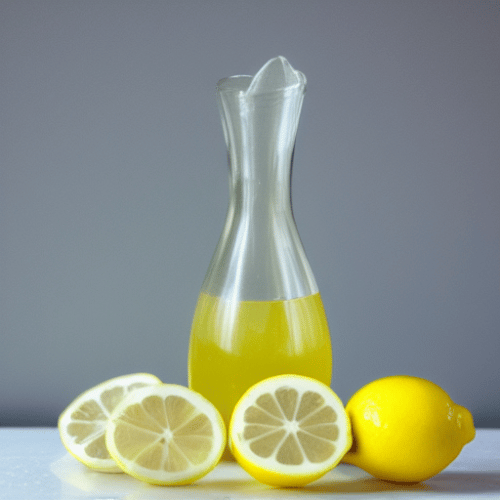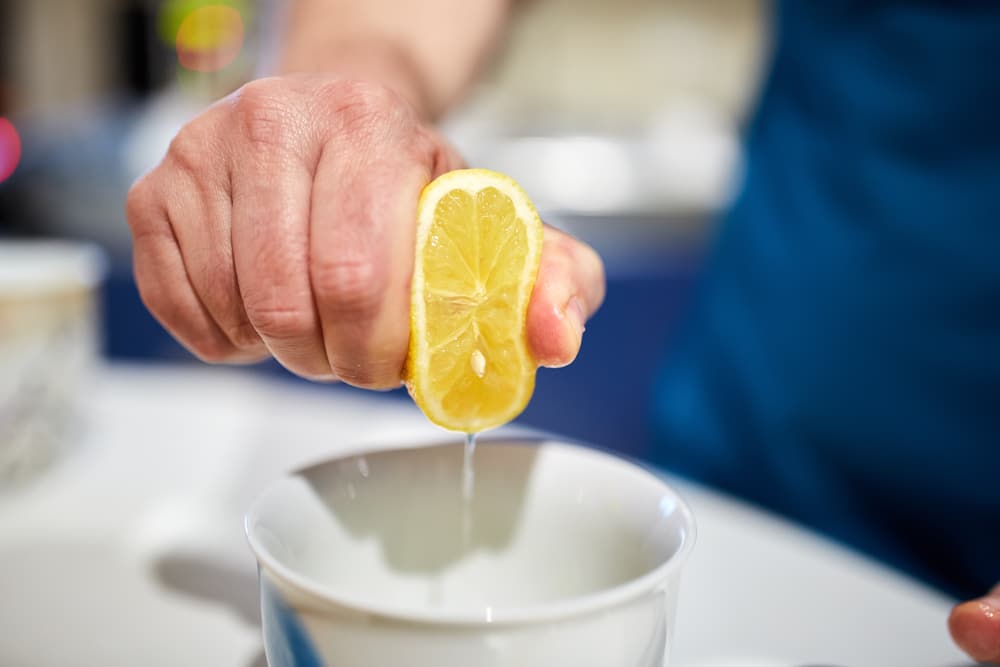Last Updated on
If you don’t have a juicer at hand or simply don’t want to have to deal with the clean-up associated with juicers, you have come to the right place. This article offers you various ways of how to juice a lemon without a juicer or any other citrus.
starting this rising w/ something electric! Pink Lemonade!
— ˚₊‧꒰ა Lav ໒꒱ ‧₊˚ (@lavndrgoddess) October 18, 2020
Freshly hand squeeze
Grapefruit & Lemon Juice 💦 pic.twitter.com/NsKYi9omb8
Methods of Getting the Most out of Your Citrus
Method 1: The Rolling Method
Many people roll their lemon or lime when they want to juice a lemon without a juicer, as you may have seen in bars and restaurants or even been told to do so in a recipe book. The rolling action loosens the lemon’s membranes, allowing most of the juice to flow and spill out easily.
We recommend rolling the fruit around on a hard surface, such as a cutting board or a kitchen worktop. But be careful not to hit the lemon too hard, as this could cause it to break. Additionally, squeezing it over a fine-mesh sieve or strainer catches all the seeds and the pulp. However, if you want a tart flavour, we suggest tossing in a bit of the pulp as well.
Tip Of The Day: in order 2 get more juice out of citrus roll on its side pressing dn on fruit. Then slice open. U will get more juice!
— Sheila Fretz (@CookUnderwriter) January 27, 2011
Method 2: Use a Fork’s Tines
Another way of getting the most juice out of your lemons or limes is by using the fork method. To get the finest results, you can even combine this one with the rolling method.
After you have rolled your lime on a hard surface and cut it open, insert the fork’s tines into the flesh of the lime and squeeze down on either side of the tines. Allow time for the juices to flow, and then rotate the fork every couple of seconds to alternate the section of lime and get more juice without using a juicer. The way in which these method works is that the pressure from the sharp fork tines pierces the lemon’s membranes, enabling more lemon juice to be released.
Furthermore, the fork also acts as a strainer while you’re squeezing, thereby reducing the number of seeds that end up in your mixing bowl.
#QuickTip Get more juice from citrus by jamming a fork into the pulp and twisting while squeezing. pic.twitter.com/VpP1dK8v20
— FastFoodie (@MHFastFoodie) March 14, 2015
Method 3: Microwave Method
This may seem a little crazy, but bear with us! Heating your lemon in a microwave before juicing for around 10–20 seconds is a simple (and effective) way to get as much juice as possible out of your fruit. However, make sure that you don’t cut the lemon in half, as the heat will soak up any moisture, resulting in the exact opposite of what you’re looking for: a dry, dehydrated lemon.
NUKE YOUR CITRUS FRUITS Zap them for 15 seconds in the microwave before squeezing to yield twice as much juice.
— Dave Zinczenko (@DaveZinczenko) April 11, 2010
Method 4: Soak Your Lemon
As with the microwave method, the heating action is important in obtaining as much juice as possible. But, if you don’t have a microwave or don’t want to use one, you also have the option of soaking your lemon in a bowl of warm water. Place the fruit inside the bowl and allow it to soak for up to one hour. Throughout this time, check on the lemon to see if it’s softening up (which is the outcome that you want). Once soft, remove it from the water, squeeze it out, and you’ll experience larger quantities of fresh juice.
In order to get more juice from a lemon – first soak it in hot water for a few seconds. Then roll the lemon before squeezing!
— Fruitflowers (@FruitFlowersNZ) June 15, 2009
Citrus Tips and Tricks
Consider the Lemon’s Temperature
The temperature of your lemons makes a big difference, so for juicing, we suggest choosing room-temperature lemons. While colder fruit can be refreshing and might be more desirable, you will be able to extract more juice from room-temperature lemons.
Cut the Lemon the Right Way
The direction you cut your lemon also makes a difference when it comes to the amount of lemon juice you receive. To fully juice lemons, ensure that you cut your fruit from top to bottom. Cutting lemons lengthwise is a great extraction method without using a juicer, as you increase the surface area of the lemon. Furthermore, you will realise that the thicker the layer of pulp that’s exposed once cut means likely to release the most juice.
Tip of the day … cut the lemon lengthwise to get the most juice out of the fruit. Also warm them in the microwave for a few seconds.
— Tregida Ltd (@Tregida) May 23, 2013
Should You Peel Lemons Before Juicing?
We recommend that you leave the peel of lemons and limes on the fruit when juicing. However, to help you decide what works best for you, here are some pros and cons.
Advantages of Leaving the Peel On
Less Mess
For starters, the notion of removing the peel from the lemon can be a messy and timely process. So make your life a little easier and skip this step. Plus, it is easier to get a good grip and squeeze the lemons with the peel left on. It might break throughout the squeezing and juicing process, but you’re more likely to get more juice this way.
Additional Nutrients
Suppose you want to give your drink or food that extra kick of citrus; add some lime or lemon zest. Lemon zest, in particular, is high in antioxidants, antibacterial compounds and vitamin C. In addition, the peel helps to reduce the chances of certain cancers, heart disease, and it boosts your immune system and lowers your blood pressure.
We don’t recommend adding the complete peel (unless your recipe calls for it), as this could result in a very bitter taste. However, grating or peeling off a few slivers adds a tangy and zesty freshness to your drink or meal. If you choose to do this, we suggest buying organic and unwaxed citrus.
Add a tangy taste with citrus juice or grated citrus peel: lemon, lime or orange. Acidic ingredients help lift and balance flavor.
— Big Barn Foods (@BigBarnFoods) June 3, 2021
Disadvantages of Leaving the Peel On
Bitter Taste
Leaving the peel on lemons can result in a bitter taste, especially when including the white underlayer. So if this is not the flavour you’re going for, we recommend that you don’t include any of the peel.
Pesticides & Wax
If using lemon zest in recipe make sure to use organic lemons. Most pesticide residues are concentrated in the peel. #lemon #organic
— Amy Stafford (@AHLFM) January 25, 2016
If you’re not buying organic fruit and vegetables, your food is likely to be covered in pesticides. Washing the lemon peel can remove some of the products but will not remove them completely. Though the chemicals are mostly food-approved, they are not recommended for consumption.
Furthermore, many lemons and limes are waxed to help preserve them. Often, even a hot water bath won’t do much to remove the wax from the peel. So, if you’re not purchasing organic fruit and want to use the peel, we suggest removing the skin and thoroughly washing your lemons.
Preserving Lemon Juice

Once you’ve chosen your approach for juicing a lemon without a juicer, you might want to consider the best ways to preserve your juice. Making lemonade is a popular choice and excellent for hot summer days. However, if you’re looking for other ideas, we have some advice for you below to help you have fresh lemon juice even days after preparing it.
Store Leftover Lemon Juice in the Freezer
An excellent strategy for keeping lemon juice fresh for longer is by squeezing the juice straight into an ice tray and freezing it. Then, when you need some fresh juice, simply remove the ice tray from the freezer the night before and place it in the refrigerator without compromising on taste or freshness. Zero prep time is required.
Don’t Keep Juice at Room Temperature
Since most of us don’t store lemons in the refrigerator, we might expect it’s okay to keep lemon or lime juice at room temperature. However, storing lemon juice at room temperature can promote bacterial growth. Therefore, we suggest keeping your juice in an airtight container in the fridge. In this way, it can last for up to three days and not lose too many of its nutrients and vitamins.
I love fresh lemon… I still juice it the old way … good old fashioned hand muscle … but to make it easier I roll the whole out of them first then zest them within an inch of their wee lives. Then I squeeze with everything I have … curd in the works folks ! pic.twitter.com/KyIK6Us7gn
— Tréssish Jáh’popé (@Tressish) June 6, 2021
Down to the Last Drop
We hope that our tips and tricks for getting every last drop and squeeze of juice out of your limes and lemons helped you. With so many ways how to juice a lemon without a juicer, it’s easy to choose a method that’s right for you.
Roll, use a fork or heat your citrus fruit- these are the different methods of juicing lemons and other citrus fruits. Now that you have the juice, what can you do with the leftovers? Share your thoughts below.
Amy is a U.K.-based writer and editor with a penchant for helping consumers find the best home products for their needs, as well as providing easily digestible guides for living better at home. Her dedication to her work means she can usually be found elbow-deep in research or hunting down samples of the latest and greatest on behalf of her readers.
An avid DIYer herself, Amy’s passion lies in teaching others how they too can achieve their dream homes by tackling some of those pesky projects themselves! Whether it’s building furniture from scratch or turning an old dresser into a coffee table, Amy is always happy to share what she knows about making your house feel like home without spending a fortune.



